Antioxidant and immunomodulatory properties of polysaccharides from Allanblackia floribunda Oliv stem bark and Chromolaena odorata (L.) King and H.E. Robins leaves
- PMID: 26651330
- PMCID: PMC4673734
- DOI: 10.1186/s13104-015-1703-x
Antioxidant and immunomodulatory properties of polysaccharides from Allanblackia floribunda Oliv stem bark and Chromolaena odorata (L.) King and H.E. Robins leaves
Abstract
Background: Many plant polysaccharides have shown high antioxidant and immunostimulating properties and can be explored as novel molecules with biological properties that can potentially improve immune function. The objective of this work was to characterize soluble and cell wall polysaccharides isolated from the stem bark of Allanblackia floribunda and Chromolaena odorata leaves and to evaluate their antioxidant and immunomodulatory properties.
Methods: Three polysaccharide fractions: soluble polysaccharides (PoS), pectins (Pec) and hemicelluloses (Hem) were extracted from A. floribunda stem bark and C. odorata leaves. These samples were analysed for their proteins, phenolic compounds and total sugar contents. The monosaccharide composition was determined by gas chromatography and arabinogalactan proteins content in PoS was evaluated by rocket electrophoresis. The in vitro antioxidant activities were evaluated by 1, 1-diphenyl-2-picryl hydrazyl (DPPH) and 2,2'-azino-bis-3-éthylbenzylthiazoline-6-sulphonic acid (ABTS) radical scavenging assays and ferrous ions chelating activity. Immunomodulatory activities were performed on the peripheral blood mononuclear cells (PBMCs) using proliferation and enzyme linked immunospot (ELISPOT) method to determine the production of an interferon-gamma.
Results: The characterization of the various fractions showed varied metabolites in each plant. In PoS fractions, Ara and Gal were the major monosaccharides found, indicating that arabinogalactans are the primary macromolecules. Hem fractions contained predominantly Xyl and GalA for A. floribunda and Xyl (upto 80 %) for and C. odorata. A. floribunda Hem fraction and C. odorata PoS fraction showed significant DPPH and ABTS radical scavenging activities and immunostimulatory activity via stimulation of PBMC and production of IFN-γ in a dose-dependent manner.
Conclusion: The results obtained from this study support the ethnomedicinal use of the stem bark of A. floribunda and leaves of C. odorata. Further research is necessary to have supporting evidence that the antioxidative and immunomodulative activities of these fractions are really connected to the polysaccharides and not polyphenols.
Figures
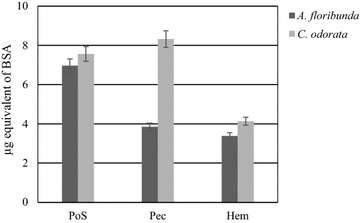
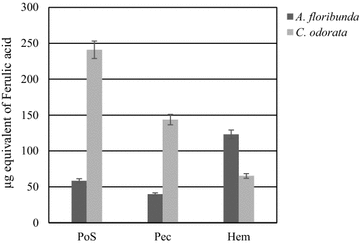
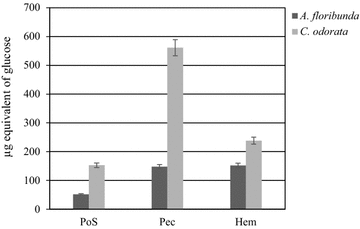
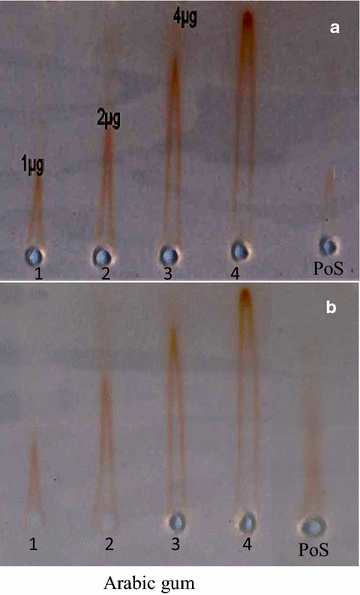
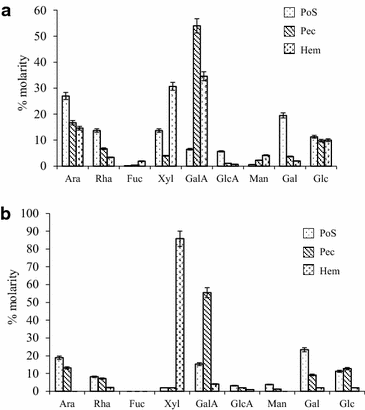
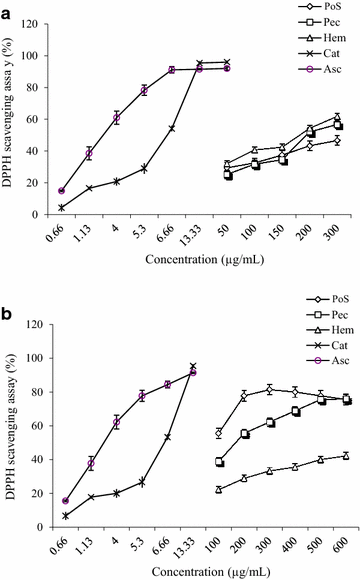
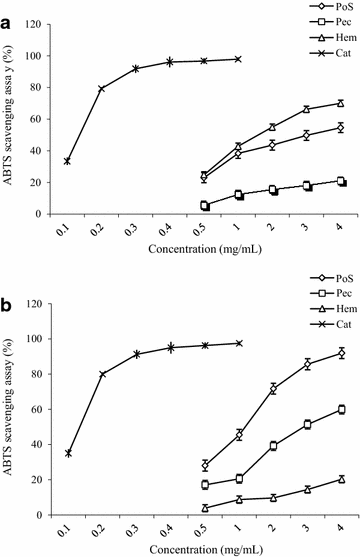
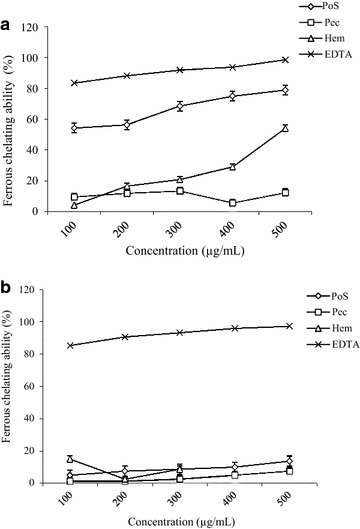
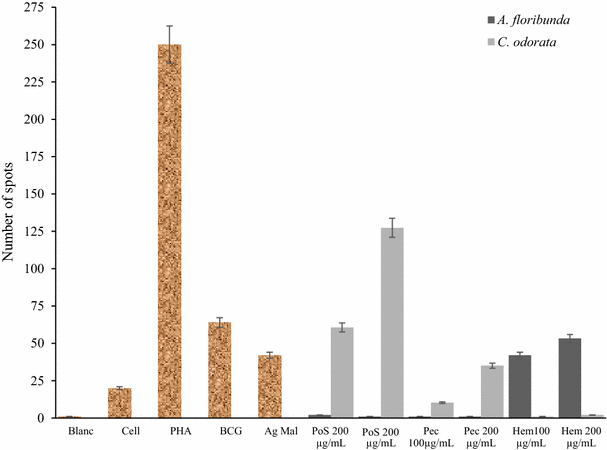
Similar articles
-
Evaluation of anti-oxidant activities and total phenolic content of Chromolaena odorata.Food Chem Toxicol. 2010 Feb;48(2):729-32. doi: 10.1016/j.fct.2009.12.005. Epub 2009 Dec 21. Food Chem Toxicol. 2010. PMID: 20026159
-
Extraction, purification and antioxidation of a polysaccharide from Fritillaria unibracteata var. wabuensis.Int J Biol Macromol. 2018 Jun;112:1073-1083. doi: 10.1016/j.ijbiomac.2018.02.070. Epub 2018 Feb 13. Int J Biol Macromol. 2018. PMID: 29447973
-
Antioxidant activities of ethanol extracts and fractions of Crescentia cujete leaves and stem bark and the involvement of phenolic compounds.BMC Complement Altern Med. 2014 Feb 4;14:45. doi: 10.1186/1472-6882-14-45. BMC Complement Altern Med. 2014. PMID: 24495381 Free PMC article.
-
Review of the recent advances in polysaccharides from Ficus carica: Extraction, purification, structural characteristics, bioactivities and potential applications.Int J Biol Macromol. 2024 Nov;281(Pt 3):136430. doi: 10.1016/j.ijbiomac.2024.136430. Epub 2024 Oct 9. Int J Biol Macromol. 2024. PMID: 39389494 Review.
-
Extraction, purification, structural characteristics, bioactivity and potential applications of polysaccharides from Semen Coicis: A review.Int J Biol Macromol. 2024 Jun;272(Pt 1):132861. doi: 10.1016/j.ijbiomac.2024.132861. Epub 2024 Jun 3. Int J Biol Macromol. 2024. PMID: 38838884 Review.
Cited by
-
Characterization of Lactic Acid Bacterium Exopolysaccharide, Biological, and Nutritional Evaluation of Probiotic Formulated Fermented Coconut Beverage.Int J Food Sci. 2024 Sep 2;2024:8923217. doi: 10.1155/2024/8923217. eCollection 2024. Int J Food Sci. 2024. PMID: 39257841 Free PMC article. Review.
-
Oligandrin from Croton oligandrus (Euphorbiaceae) exhibits anti-breast cancer activity through immune-boosting mechanisms: In vitro and in vivo study.Heliyon. 2024 Jul 23;10(15):e35000. doi: 10.1016/j.heliyon.2024.e35000. eCollection 2024 Aug 15. Heliyon. 2024. PMID: 39166076 Free PMC article.
-
Allanblackia floribunda Seed Extract Attenuates the Ethanol-Induced Gastric Ulcer in Rats via the Inhibition of TNF-α and INF-γ Levels and Modulation in the Expression of Ki67 Protein.Biomed Res Int. 2021 Jan 11;2021:6694572. doi: 10.1155/2021/6694572. eCollection 2021. Biomed Res Int. 2021. PMID: 33521129 Free PMC article.
-
Ethnobotanical Survey of Medicinal Plants Used in the Treatment of COVID-19 and Related Respiratory Infections in Ogbomosho South and North Local Government Areas, Oyo State, Nigeria.Plants (Basel). 2022 Oct 10;11(19):2667. doi: 10.3390/plants11192667. Plants (Basel). 2022. PMID: 36235532 Free PMC article.
-
Phytochemistry, Biological, and Toxicity Study on Aqueous and Methanol Extracts of Chromolaena odorata.ScientificWorldJournal. 2023 Oct 9;2023:6689271. doi: 10.1155/2023/6689271. eCollection 2023. ScientificWorldJournal. 2023. PMID: 37849963 Free PMC article.
References
-
- Aboughe-Angone S, Nguema-Ona E, Boudjeko T, Driouich A. Plant cell wall polysaccharides as immmunomodulators of the immune system. Cur Top Phytochem. 2011;10:1–16.
-
- Thangam R, Sathuvan M, Poongodi A, Sureshe V, Pazhanichamy K, Sivasubramanian S, Kanipandian N, Ganesan N, Rengasamy R, Thirumurugan R, Kannan S. Activation of intrinsic apoptotic signaling pathway in cancer cells by Cymbopogon citratus polysaccharide fractions. Carbohydr Polym. 2014;107:138–150. doi: 10.1016/j.carbpol.2014.02.039. - DOI - PubMed
MeSH terms
Substances
LinkOut - more resources
Full Text Sources
Other Literature Sources
Medical
Miscellaneous

